This was published 3 years ago
Social distancing on planes: Why new seat designs won't take off
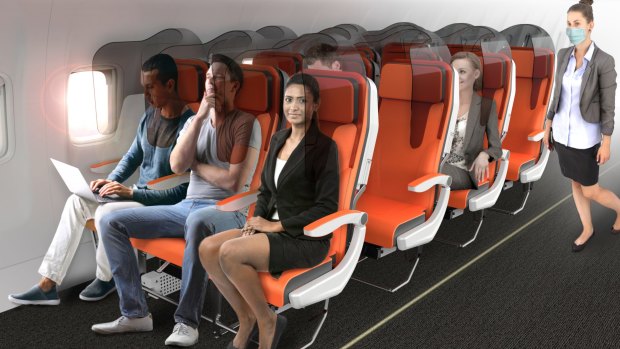
The Glasssafe seat design puts screens between economy class passengers.
As airlines start to recover from the pandemic lockdowns and rebuild their customer base, seat designers have got their creative juices flowing.
Makes sense, right? Reassuring economy-class travellers they won't get COVID-19 from flying is key. Airlines have proven they are not going to leave seats vacant but if there are seats that enhance social distancing, bingo – game on.
The Glasssafe is the simplest option, a plexiglass halo that can be fitted to existing economy seats to wrap over and around the passenger's head, like a nun's wimple. Less exposure to fellow passengers equals lower risk, although tests prove that in a sneeze, splatter particles travel several metres from the mouth of the sneezer. That noxious spray is sucked into the vents in the aircraft's circulation system, potentially entering the respiratory systems of several other passengers before it's processed through the aircraft's HEPA filters.
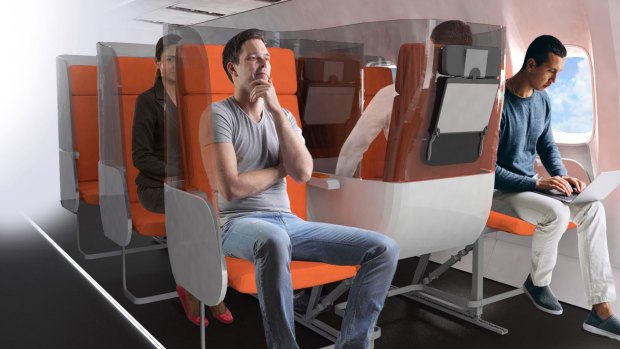
The Janus design.
Next step up is the Janus, in which the middle seat on a row of three faces backwards, with a head-to-armrest wraparound shield separating each passenger. That puts the middle, rear-facing passenger into eye contact with the passengers seated on either side of them in the row behind, and that's slightly awkward. Also, on aircraft with a 3-4-3 configuration in economy class, how to arrange those middle quad seats becomes problematic.
Both these designs come from the same stable, Italy's Aviointeriors. It was Aviointeriors that first proposed the "SkyRider" saddle-style seats. That got them a lot of attention but no airline has shown any interest, and you have to wonder whether the Glassafe and Janus are more about headlines than health.
The Zephyr, a brave leap
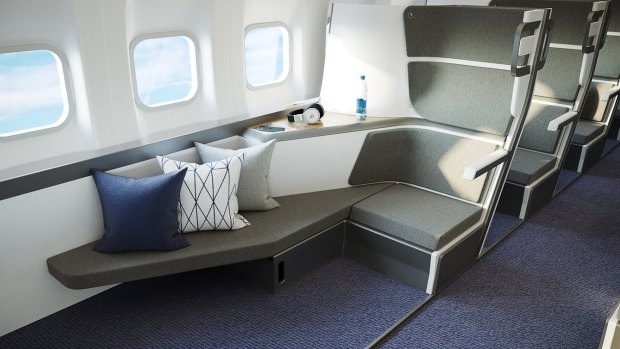
One totally left-field approach is the Zephyr Seat (above), designed for economy cabins and created by Jeffrey O'Neill, CEO of Zephyr Aerospace. By doing away with the overhead bin, the Zephyr Seat stacks another tier of seats above those on the main deck of a wide-body aircraft, claiming to maintain the same 2-4-2 configuration and the same number of passengers as in a traditional economy cabin. Social distancing is enhanced and every passenger gets more room. Enough, in fact, to fully recline, although in a slightly less plush manner than in a lie-flat business class seat.
A mock-up of a cabin interior fitted with Zephyr Seats shows a stepladder giving access to upper-tier seats, but that suggests one ladder per upper seat. That adds up to a lot of wasted space, as well as presenting a problem for less agile passengers. Another problem, the floor on the upper tier is just 137cm above the floor of the main cabin, which ratchets headroom for lower-tier passengers down to head-bonking level.
Even if the Zephyr Seat was technically viable, a lie-flat seat is what many business class travellers are paying for. Installing a lie-flat seat in premium economy would endanger airlines' lucrative business model, from which they derive a high proportion of their revenue. Conceptually bold, the Zephyr Seat is never going to get off the ground.
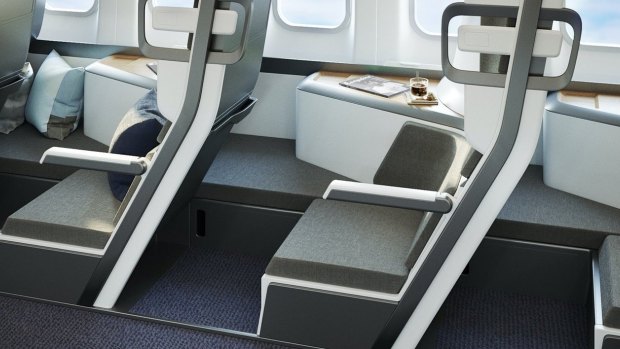
Why coronavirus is not going to change aircraft seating
Hamburg's annual Aircraft Interiors Expo never fails to generate intriguing new seat designs that offer a different kind of economy-class experience, but airlines have never shown much enthusiasm for departing from the sardine-can experience.
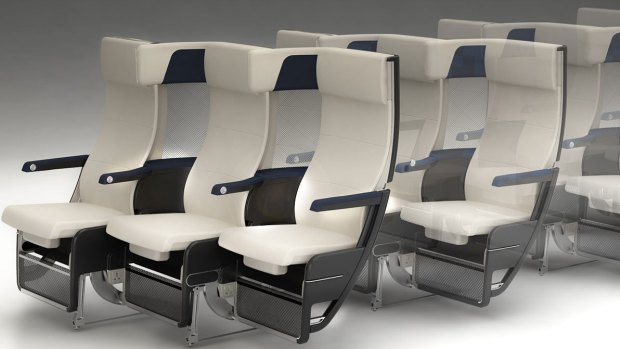
The Cozy Suite from Thompson Aero Seating (above) offered a wider seat, individual armrests for all passengers and improved aisle access, but after some interest from Delta the airline nixed the concept. Air New Zealand's Skycouch never found traction with other airlines, apart from a brief flirtation from China Airlines, although the airline's flyers applauded.
There are a number of hurdles for seat designers looking to convince airlines to change their seats in response to the pandemic. As well as better hygiene, seat designers need to demonstrate to airlines that their concept offers material advantages by way of cost, weight saving and passenger enthusiasm. Then comes regulatory approval, which involves tests for fireproofing and proving that the new seat will not jeopardise passenger safety. By the time the seat rolls off the production line and hosts human bottoms for the first time, years will have passed – and who knows what the status of coronavirus will be by then?
Airlines have been haemorrhaging cash. A basic economy-class seat such as those favoured by budget airlines starts at around $4400. A more comfortable version costs around $7300. An airline is not going to hoik out their existing seats, and unlikely to take a chance on a different and probably more expensive version in newly acquired aircraft.
Passengers don't care. In Europe, North America and on domestic flights within Australia, passenger numbers are ramping up. Mostly those passengers are happy just to be flying. Seating concerns? That's way down the list of passenger priorities. Those who care about their health should be wearing a mask and implementing their own hygiene protocols. Unless it's demonstrated that sitting in an aircraft, in the traditional economy-class configuration, exposes you to a greater risk of coronavirus, why would airlines try and fix something that ain't broke?
See also: Personal space: The most socially distant seats in the sky
Sign up for the Traveller newsletter
The latest travel news, tips and inspiration delivered to your inbox. Sign up now.